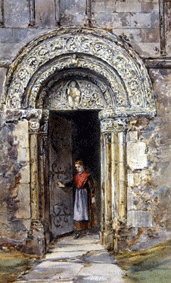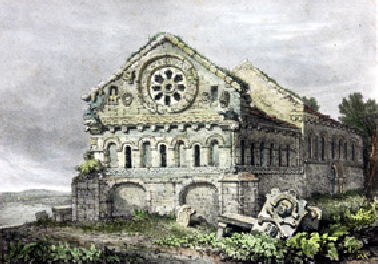






Little is known of the original foundation of the church. In A Guide to Barfreystone Church and its World Famous Carvings, F H Worsfold associates it with the de Port family. Hugo de Port, a sub-constable of Dover Castle in 1079, was first granted the Manor of Barfreystone. His great-grandson, Adam de Port married the wealthy Mabil d'Orval from Normandy in 1180. Was the church a thanksgiving?
Stylistically the carving is late 12th century. The architect R C Hussey who oversaw the restoration in 1840 found that the material had been used before, and some stones had been (and are still!) misplaced in Barfreston Church. He contended that Archbishop Baldwin's chapel at Hackington was the source of the masonry. The Hackington chapel was demolished after the Archbishop's death in 1190, possibly to prevent it rivalling
Christchuch Canterbury as a magnet for pilgrims. In its turn, Barfreston became a site on the pilgrim route between Dover and Canterbury.
Christchuch Canterbury as a magnet for pilgrims. In its turn, Barfreston became a site on the pilgrim route between Dover and Canterbury.
By the early 19th century the church was falling into ruin, having been damaged in a landslip. In Hussey, it found a supremely conscientious and careful restorer. His account of his work (including the rebuilding of the chancel) is published in Archaeologia Cantiana XVI 1886.
Engraved by S Prout, published Jan 1 1823
A water colour by Caroline Eugenia St John Mildmay, late 19th century